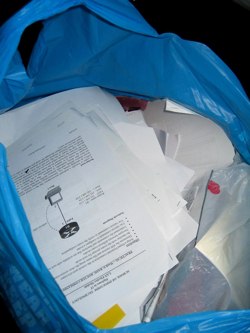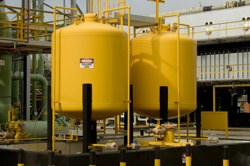Earthtalk is a weekly environmental column made available to our readers from the editors of E/The Environmental Magazine
 Dear EarthTalk: I want to convince my high school to go green. What would it cost for a school to switch to all recycled paper products and all energy efficient lighting?
Dear EarthTalk: I want to convince my high school to go green. What would it cost for a school to switch to all recycled paper products and all energy efficient lighting?
-Danel Berman, via e-mail
Greening your school is a great idea. It will not only benefit the environment but the student body as well. According to the “Greening America’s Schools” report, sponsored in part by the non-profit U.S. Green Building Council (USGBC), green buildings provide a better study and learning environment for students. Improved lighting, air quality and acoustics are estimated to improve learning abilities and test scores by as much as five percent. And what better way to teach young people about the importance of environmental stewardship than starting right in the schools where they spend the majority of every weekday?
Since every school is different, there is no universal formula for calculating how much money going green will cost. Switching over to recycled paper, for instance, will not necessarily be cheap. A recent spot-check at a national office supply chain showed that the price for a ream (500 sheets) of 30 percent recycled copy paper was 20 percent higher than a ream with no recycled content. If you chose 100 percent recycled content, you would pay 35 percent more per ream. But prices can vary widely depending upon where you buy paper, and bulk purchasers like schools may be able to negotiate much better prices.
The best way to offset the added costs of switching to recycled paper is to cut paper usage at the same time. Start a program to educate students about how they can reduce paper waste by printing on both sides of a sheet and by not printing as many drafts, for example. You can also encourage your school to switch to e-newsletters instead of paper ones and find other ways to reduce administrative paper use.
Switching to recycled paper is definitely a big win for the environment. The Natural Resources Defense Council (NRDC) reports that 40 cases of 30 percent recycled copy paper (400 reams) will save more than seven trees, 2,100 gallons of water, 1,230 kilowatt-hours of electricity and 18 pounds of air pollution.
You can calculate this impact for your school. Ask your school purchaser how much printer/copier paper is purchased, and calculate its weight in pounds or tons. Then go to the Environmental Defense Fund’s online Paper Calculator. Enter the weight and type of paper you use and you can determine the amount of wood, energy, water, solid waste and greenhouse gas emissions you’ll save by switching to recycled.
As for lighting, many schools already use a lot of fluorescent lighting. If your school still uses incandescent bulbs, consider that for every 60-watt incandescent bulb switched to a 13-watt compact fluorescent, the school could save 75 percent in energy use—an average of $45 over the life of each bulb.
Ambitious schools can also put in occupancy sensors that turn lights off when rooms are vacant, or install task lighting to further reduce energy usage. Such add-ons might seem like luxuries for already strapped schools, but it just may be worthwhile anyway given the energy that can be saved and the lessons learned.
CONTACTS:
EnergyStar
U.S. Green Building Council
Natural Resources Defense Council
Green Schools Initiative
Environmental Defense Fund’s Paper Calculator
————
 Dear EarthTalk: With all the talk of desalinization of ocean water for drinking, what do we know about the impacts this might have on climate, ocean salinity and other natural processes?
Dear EarthTalk: With all the talk of desalinization of ocean water for drinking, what do we know about the impacts this might have on climate, ocean salinity and other natural processes?
– Fred Kuepper, via e-mail
Due to its high cost, energy intensiveness and overall ecological footprint, most environmental advocates view desalinization (or desalination)—the conversion of salty ocean water into fresh water—as a last resort for providing fresh water to needy populations. Sourcing fresh water from streams, rivers, lakes and underground aquifers and adhering to strict water conservation measures are much more viable for both economic and environmental reasons in most situations, although some desert regions with thirsty and growing populations may not have many such options.
The relationship between desalinization and climate change is complex. Global warming has increased droughts around the world and turned formerly verdant landscapes into near deserts. Some long held fresh water sources are simply no longer reliably available to hundreds of millions of people around the world.
Meanwhile, expanding populations in desert areas are putting intense pressure on existing fresh water supplies, forcing communities to turn to desalinization as the most expedient way to satisfy their collective thirst. But the process of desalinization burns up many more fossil fuels than sourcing the equivalent amount of fresh water from fresh water bodies. As such, the very proliferation of desalinization plants around the world—some 13,000 already supply fresh water in 120 nations, primarily in the Middle East, North Africa and Caribbean—is both a reaction to and one of many contributors to global warming.
Beyond the links to climate problems, marine biologists warn that widespread desalinization could take a heavy toll on ocean biodiversity; as such facilities’ intake pipes essentially vacuum up and inadvertently kill millions of plankton, fish eggs, fish larvae and other microbial organisms that constitute the base layer of the marine food chain. And, according to Jeffrey Graham of the Scripps Institute of Oceanography’s Center for Marine Biotechnology and Biomedicine, the salty sludge leftover after desalinization—for every gallon of freshwater produced, another gallon of doubly concentrated salt water must be disposed of—can wreak havoc on marine ecosystems if dumped willy-nilly offshore. “For some desalinization operations,” says Graham, “it is thought that the disappearance of some organisms from discharge areas may be related to…the salty outflow.”
Of course, as supplies of fresh water dwindle, the economic cost of desalinization—especially in coastal areas with easy access to ocean water—begins to look competitive with traditional water sourcing. To date there are about 300 desalinization plants in the United States, with 120 in Florida and less than 40 each in Texas and California. Some 20 additional plants are planned for the coast of California in the coming years, unless environmentalists extolling the virtues of conservation and wielding low-flow shower heads and toilets prevail.
CONTACT: Scripps’ Center for Marine Biotechnology and Biomedicine
GOT AN ENVIRONMENTAL QUESTION?
- Send it to: EarthTalk, c/o E/The Environmental Magazine, P.O. Box 5098, Westport, CT 06881
- Submit it at: www.emagazine.com/earthtalk/thisweek/, or e-mail: earthtalk[at]emagazine.com.
- Read past columns at: www.emagazine.com/earthtalk/archives.php.
E – The Environmental Magazine
Image Credits: jeremyfoo, courtesy Flickr; smthns, courtesy Flickr



Thank you very muchfor your immediet response !!!!
Stil I need more information on global role and impacts of school environmental clubs